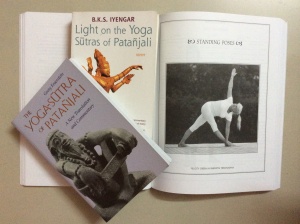How Important is Yoga Asana in India?
Another glorious sunrise over McLeod Ganj; eagles soaring in wide circles and birds singing happily, and as I sit on the balcony, I think about the class I taught last night as part of our teacher training. I smile and remember how at one moment during the class, I looked out over the valley and thought, “Holy crap! I’m standing at the foothills of the Himalayas and actually teaching a YOGA class, in INDIA!” And how much delight that brought me. The hundreds of times I’ve instructed my way through Adho Mukha Svanasanas and Utthita Trikonasanas, were all stepping stones to bring me to this point of my yoga studies.
Part of why I’ve come to India to complete my 500 hours of yoga teacher training is because I want to know more than how you place your feet in Utthita Trikonasana (Triangle Pose), or how to wrap your shoulders in Adho Mukha Svanasana (Downward Facing Dog). I want to learn more about the history, psychology and philosophy of yoga.
So, it’s interesting to hear Yogi Sivadas‘ perspective on the yoga Asanas (physical poses) and how they really are just a tiny part of what Yoga encompasses. Our obsession with yoga in the West as a fitness regime, a way to get a beautiful body, or rock a spectacular arm balance pose, seems superficial when he points out that there are 196 lines in the yoga Sutras (the 2,200+ year old summary of Yoga), and only 3 of those lines are about asana! And in the West, we often ignore the important message in those 3 lines, of coming into/being in a pose “with ease and steadiness”.
According to Patanjali, who wrote the Yoga Sutras, “Yoga pose is a steady and comfortable position. Yoga pose is mastered by relaxation of effort, lessening the tendency for restless breathing, and promoting an identification of oneself as living within the infinite breath of life.”
Wow! That sounds good! Is that what your yoga practice is like? Or do you push yourself too hard in yoga? We don’t need to overextend ourselves; we don’t even need to hold the poses to our maximum effort, because when the muscles fatigue, they don’t work efficiently anymore anyway, and the joints over stretch. And that’s when injuries happen.
“Asana is the coconut shell of Yoga,” says Yogi Sivadas. “It’s necessary; we need it, but we have to break through the shell to get to the sweetness of Yoga, inside” – to get to the parts of Yoga that extend beyond the physical poses, exploring healthy philosophies and ethics and calming the mind.
Some other interesting viewpoints, which make sense to me:
- Yoga doesn’t begin on the yoga mat, through Asana – Yoga begins when your lifestyle and diet are regulated and healthy
- Yoga pose is mastered by relaxation of effort
- Hatha Yoga (physical yoga) is a preparation for a higher practice,” i.e. Pranayama, meditation and an awakening
“Rest as much as you need. Always be mindful of what your body needs,” is the constant reminder from Yogi Sivadas during our asana practice. He’s not into kick-ass, Facebook-showoff yoga poses, even though he can easily flip into full Salabhasana pose, with his chin on the earth and his feet and legs way up above his head, stretching to the sky. Or jump into a crazy arm balance pose, with his legs in Padmasana (Lotus Pose).
The point is, he doesn’t need to nail these poses in order to be “good at yoga”. He’ll do them for us if we want to see how to come into the pose, but his continuous message is to stretch, breathe, feel the poses in the body, and only do what the body needs, without over exertion. And for the super-bendies who can pretzel their way through multiple poses, it’s mostly genetic, and sure, it looks pretty, but they have different work to do; they need to do less stretching and will benefit more from strengthening their muscles and protecting their joints.
Perhaps if we practice yoga with this type of awareness, we can explore the value of the other 193 lines in the Yoga Sutras!




Wow! What wisdom!
The longer I stay here, the more I realize how simple the wisdom is!